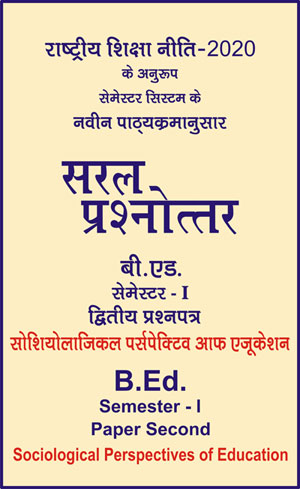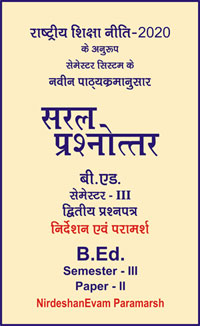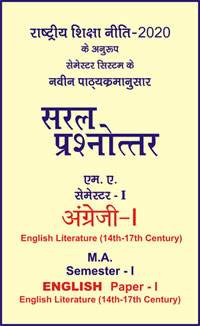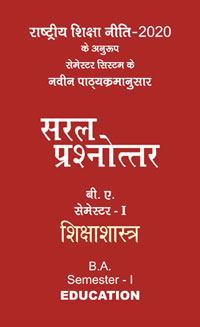|
बी एड - एम एड >> बी.एड. सेमेस्टर-1 प्रश्नपत्र-II - सोशियोलाजिकल पर्सपेक्टिव आफ एजूकेशन बी.एड. सेमेस्टर-1 प्रश्नपत्र-II - सोशियोलाजिकल पर्सपेक्टिव आफ एजूकेशनसरल प्रश्नोत्तर समूह
|
|
|||||||
बी.एड. सेमेस्टर-1 प्रश्नपत्र-II - सोशियोलाजिकल पर्सपेक्टिव आफ एजूकेशन (अंग्रेजी भाषा मे)
Question- Write a detailed note on “Preamble to the constitutions of India”.
Ans.
Preamble to the Constitution of India
The Preamble to the Constitution of India presents the principles of the Constitution and indicates the sources of its authority. It was adopted on 26 November 1949 by the Constituent Assembly and came into effect on 26 January 1950, celebrated as the Republic day in India.
We, The People of India, having solemnly resolved to constitute India into a Sovereign socialist Secular Democratic Republic and to secure to all its citizens:
Justice, social, economic and political;
Liberty of thought, expression, belief, faith and worship;
Equality of status and of opportunity; and to promote among them all.
Fraternity assuring the dignity of the individual and the unity and integrity of the Nation;
In our Constituent Assembly this twenty-sixth day of November, 1949, do Hereby Adopt, Enact and Give to ourselves this Constitution.
The Constituent Assembly debated the Preamble on 17th October 1949. The debates around the Preamble revolved around the name of 'India and inclusion of ‘God’ and ‘Gandhi’.
Historic Background - The preamble is based on the Objectives Resolution, which was drafted and moved in the Constituent Assembly by Jawaharlal Nehru on 13 December 1946 and adopted by Constituent Assembly on 22 January 1947.
The Supreme Court of India originally stated in the Berubari case presidential reference that the preamble is not an integral part of the Indian constitution, and therefore it is not enforceable in a court of law. In the 1995 case of Union Government Vs LIC of India, the Supreme Court once again held that the Preamble is an integral part of the Constitution.
As originally enacted the preamble described the state as 'a sovereign democratic republic", to which the terms “Secular” and “Socialist” were later passed by a Captive Parliament during The Emergency in the 42nd Amendment.
The preamble-page, along with other pages of the original Constitution of India was designed and decorated by the renowned painter Beohar Rammanohar Sinha of Jabalpur who was at Shantiniketan with Acharya Nandalal Bose at that time.
The preamble was amended only once on 18 December 1976, with most of the opposition being jailed during the Emergency in India, the Indira Gandhi government pushed through several changes in the Forty-second Amendment of the constitution. Through this amendment, the words “socialist” and “secular” were added between the words “Sovereign” and “democratic” and the words “unity of the Nation” were changed to “unity and integrity of the Nation.”
Interpretation is given as under -
• Sovereign - Sovereign means the independent authority of a State. It means, that it has the power to legislate on any subject; and that it is not subject to the control of any other State / external power.
Sovereign Democratic Republic’, and to secure well-defined objects set forth in the preamble. Sovereignty denotes supreme and ultimate power. It may be real or normal, legal or political, individual or pluralistic. In monarchies, sovereignty was vested in the person of monarchs. But in republican form of governments, which mostly prevail in the contemporary world, sovereignty is shifted to the elected representatives of the people. According to D.D Basu, the word ‘sovereign’ is taken from article 5 of the constitution of Ireland. ‘Sovereign or supreme power is that which is absolute and uncontrolled within its own sphere’. In the words of Cooley, “A state is sovereign when there resides within itself supreme and absolute power, acknowledging no superior”.
Sovereignty, in short, means the independent authority of a state. It has two aspects- external and internal. Pandit Nehru declared that India will continue – “her full membership of the Commonwealth games of Nations and her acceptance of the King as the symbol of the free association of the independent nations and as such the Head of the Commonwealth”.
• Socialist - Before the term was added by the 42nd Amendment in 1976, the Constitution had socialist content in the form of certain Directive Principles of State Policy. The term socialist used here refers to democratic socialism, i.e. achievement of socialist goals through democratic, evolutionary and non-violent means.
• Secular - Secular means that the relationship between the government and religious groups are determined according to constitution and law. It separates the power of the state and religion. By the 42nd Amendment in 1976, the term “Secular” was also incorporated in the Preamble. There is no difference of religion i.e. Hinduism, Buddhism, Jainism, Sikhism, Christianity and Islam are equally respected and moreover, there is no state religion. All the citizens of India are allowed to profess, practice and propagate. Explaining the meaning of secularism as adopted by India, Alexander Owics has written, “Secularism is a part of the basic structure of the Indian Constitution and it means equal freedom and respect for all religions.”
• Democratic - The people of India elect their governments by a system of universal adult franchise, popularly known as “one person one vote”. Every citizen of India 18 years of age or older and not otherwise debarred by law is entitled to vote. The word democratic refers not only to political democracy but also to social and economic democracy.
• Republic - In a republican form of government, the head of state is elected and not a hereditary monarch. Thus, this word denotes a government where no one holds public power as a proprietary right. As opposed to a monarchy, in which the head of state is appointed on a hereditary basis for life or until abdication, a democratic republic is an entity in which the head of state is elected, directly or indirectly, for a fixed tenure. Thus, India has a president who is indirectly elected and has a fixed term of office.
• Justice - Justice stands for rule of law, absence of arbitrariness and a system of equal rights, freedom and opportunities for all in a society.
India seeks social, economic and political justice to ensure equality to its citizens.
• Liberty - The idea of Liberty refers to the freedom on the activities of Indian nationals. This establishes that there are no unreasonable restrictions on Indian citizens in terms of what they think, their manner of expressions and the way they wish to follow up their thoughts in action.
• Equality - The term ‘equality’ means the absence of special privilege to any section of society, and the provision of adequate opportunity of all the individuals without any discrimination.
• Fraternity - This refers to a feeling of brotherhood and sisterhood and a sense of belonging with the country among its people. The Preamble declares that fraternity has to assure two things—the dignity of the individual and the unity and integrity of the nation. The word ‘integrity’ has been added to the Preamble by the 42nd Constitutional Amendment (1976).
Amendability - In the Berubari Case (1960), the amendability & the significance of the constitution came into force. An important & very interesting question was raised relating to the powers of the Parliament to cede Indian territory to a foreign country, as an interpretation of the Article 3. The Supreme Court had held that the power of Parliament to diminish the area of a state as guaranteed in Article 3 of the Constitution does not cover cession of the Indian territory to a foreign country. Hence, Indian territory can be ceded to a foreign country only by means of amendment of the Constitution under the Article 368. Consequently, the 9th Constitutional Amendment Act, 1960 was enacted to transfer the Berubari Union to Bangladesh (erstwhile East Pakistan). Supreme Court also held the view that Preamble cannot be a part of the constitution but later in Kesavananda Bharti Case (1973), the Supreme Court gave a comprehensive verdict. It said that Preamble is part of the Constitution and is subject to the amending power of the parliament as are any other provisions of the Constitution, provided the basic structure of the Constitution is not destroyed.
It has been clarified by the Supreme Court of India that, being a part of the Constitution, the Preamble can be subjected to Constitutional Amendments exercised under article 368, however, the basic Structure cannot be altered. Therefore, it is considered as the heart and soul of the Constitution.
Forty-Second Amendment - The preamble has been amended only once so far. On 18 December 1976, during the Emergency in India, the Indira Gandhi government pushed through several changes in the Forty-Second Amendment of the constitution.
Constitution (Amendment) Bill, 2021 - During the 2021 winter session of parliament, a private member sought to introduce a bill to amend the preamble.
|
|||||

 i
i 










